KM Component 11 – KM Incentives and Rewards

Stan Garfield
Incentives and rewards are programs designed to encourage compliance with goals, improve performance against metrics, and increase participation in KM initiatives.
These can include performance ratings, salary increases, promotions, promotion requirements, tangible rewards, recognition, competitive rankings, badging, and gamification
There are several differing schools of thought on whether or not to provide special rewards for desired knowledge behaviors. One school holds that incentives can yield short-term results when introducing a change initiative, but that the effects wear off over time. Another is that people will manipulate such programs to gain the rewards without achieving the desired results (e.g., submit lots of documents with low quality or no reuse benefit). And a third is that you need to provide incentives for people or else they won’t do what you want.
It’s worth testing these assumptions with pilots for different types of programs. Here is a review of five types of incentives you can try.
Performance ratings and salary increases
In conjunction with goals and measurements, you can specify that those who excel in achieving their KM goals will receive higher performance ratings and associated salary increases. Another option is to require that individual KM goals must be achieved in order to receive an above-average rating or increase.
For example, if a firm has three levels of performance ratings – fails to meet expectations, meets expectations, and exceeds expectations – you can specify that only those who achieve their KM goals can receive the highest rating, despite what other great accomplishments they may have. This will likely get everyone’s attention.
Promotion requirement
For some job types, you can require that knowledge sharing behaviors be consistently demonstrated as a condition of advancement to higher-level positions. For example, technical experts, project managers, and people managers can be held accountable for providing examples of how they shared, collaborated, and innovated using components of the KM environment. If they don’t provide such evidence, they are not promoted.
Communications announcing promotions should be widely distributed, and should include details on how the individuals shared their knowledge. This will provide examples for others working toward career advancement and give them something to strive for.
Tangible rewards
With the approval of your human resources function, you can give money or prizes for the top contributors, top reusers, frequent contributors, frequent reusers, leaders, those who volunteer their time, those who achieve targets, or those selected by leaders or peers. Communicate the rules in advance so everyone will know how to win the awards.
Here are ten examples of different ways to offer rewards.
- The people who submit the proven practices which are the five most reused will each win a financial reward.
- The five top project teams in terms of content reused in their projects will be allowed to attend the industry conference of their choice.
- For every five lessons learned documents contributed which meet quality standards, an individual earns a gift certificate.
- Those who reuse content as part of three new proposals win the book of their choice.
- Those who lead a community of practice for one year win the latest piece of technology that is in demand.
- Everyone who participates in a content creation initiative for three months or more wins a subscription to the journal of their choice.
- All members of a region which achieves its KM goals receive a bonus.
- Those who receive the top ten most votes from their peers for sharing the most win a weekend trip for two.
- Those who receive the top ten most votes from their leaders for outstanding knowledge-related behaviors are invited to attend a gala event.
- Those who receive the top ten most points in competitive rankings (see below) win a financial reward.
The value of rewards does not have to be great in order to motivate people. The desire to compete, earn something free, and be acknowledged as a winner can be powerful incentives.
Recognition
Incentives don’t have to cost anything to be effective. Just knowing that you have earned the attention, respect, and admiration of others, especially senior leaders, can be very gratifying. And you are more likely to repeat desired behaviors if you know that important people will take notice.
Among the ways to provide non-financial recognition are personal notes from leaders who notice contributions, newsletter articles about those who achieve success in using KM processes, success stories posted to web sites, invitations to attend prestigious events hosted by the senior executive, scheduling time with senior technical leaders for exchanges of ideas, and being praised and asked to talk about their efforts in conference calls or meetings.
Competitive rankings
To take advantage of the competitive nature of many individuals, an incentive points system can be implemented to award points for desired behaviors, rank those earning points, and report on weekly, monthly, yearly, and lifetime standings. The points awarded can be used for recognition, tangible rewards, or for demonstrating achievement of goals for performance reviews and promotions.
Point totals can vary by task, can be claimed by filling in a form, or can be received automatically as a result of performing a task in another application. The point totals and rankings can be reported on web sites, in newsletters, and via messages to employees and managers.
Here’s an example of how such a system can work. Create an application which allows users to claim points for doing different types of activities, such as giving community presentations, publishing a white paper, acting as a subject matter expert for an ask the expert program, serving as a moderator for a threaded discussion forum, and doing a variety of other knowledge-related tasks.
Each task has assigned to it a certain point value. And each time someone does one of these knowledge sharing or reuse functions, they can claim the points in the system. The points earned are displayed on a web site to create a friendly competition among all employees. They can visit the site to see how they stack up against their peers, the idea being to create some fun, to show that people are in fact spending some of their time on KM, and to recognize them for that.
Capturing points for all of the tasks should be automated. For example, any time someone posts to a threaded discussion, they should automatically get points for that. Every time someone subscribes to a new threaded discussion, they earn points. When they tag or rate content, they earn points. If they contribute a document to a repository, points are awarded. The awarding of points is done automatically by the system.
Try to combine as many of these techniques as possible. For example, implement a competitive rankings system. Employees can use data from the system during performance reviews. They can submit details from the system when applying for promotions. The top point earners can be given tangible rewards. Those who exceed a targeted point threshold can be recognized as knowledge leaders. And communications vehicles can provide profiles of leaders and interviews with details on their success stories.
For more on using praise and thanks, see Thankful Thursdays: Using Praise to Motivate Knowledge Sharing. It also includes links to previous posts and webinars about gamification and digital badging.
Example: HP’s KM Stars Program
HP’s program started with recognition only. This was done through a monthly list of the individual rankings, which was promoted on the intranet, in the monthly KM newsletter, and in the KM blog.
Later, the senior vice president agreed to add financial rewards to the program. Three winners were selected each month. The winners were required to write a story on how they became a KM Star.
Winners were widely publicized. An email message was sent to the leadership team and to the management chain of each winner.
A lively competition ensued, especially in the UK. No repeat winners were allowed, and all three regions of the world were included in the selection process.
There was one instance of gaming the system, in which someone posted regularly in the threaded discussion forums with little value. This was addressed successfully, and that behavior ceased.
KM Stars points were included in everyone’s personal profiles in the me@HP social networking platform. The success of the KM Stars program led to its adaptation and use at other companies, including Accenture and IBM.

Stan Garfield
Please read Stan’s additional blog posts offering advice and insights drawn from many years as a KM practitioner. You may also want to download a copy of his book, Proven Practices for Implementing a Knowledge Management Program, from Lucidea Press. And learn about Lucidea’s Inmagic Presto and SydneyEnterprise with KM capabilities to support successful knowledge curation and sharing.
Never miss another post. Subscribe today!
Similar Posts
Only You Can Prevent Knowledge Loss: How to Practice “Knowledge Archaeology”
An overview of ways in which knowledge is lost, with examples of how to perform knowledge archaeology to recover and restore it.
Ready to Read: Profiles in Knowledge: 120 Thought Leaders in Knowledge Management
We are pleased to announce that Stan Garfield’s new book, Profiles in Knowledge: 120 Thought Leaders in Knowledge Management, is now available from Lucidea Press.
Lucidea’s Lens: Knowledge Management Thought Leaders Part 92 – Jay Liebowitz
Jay Liebowitz is a professor, consultant, author, and editor. His research interests include knowledge management, data analytics, intelligent systems, intuition-based decision making, IT management, expert systems, and artificial intelligence.
Lucidea’s Lens: Knowledge Management Thought Leaders Part 91 – Frank Leistner
The late Frank Leistner was the former Chief Knowledge Officer for SAS Global Professional Services, where he founded the knowledge management program and led a wide range of knowledge management initiatives up until 2012.




Leave a Comment
Comments are reviewed and must adhere to our comments policy.
0 Comments